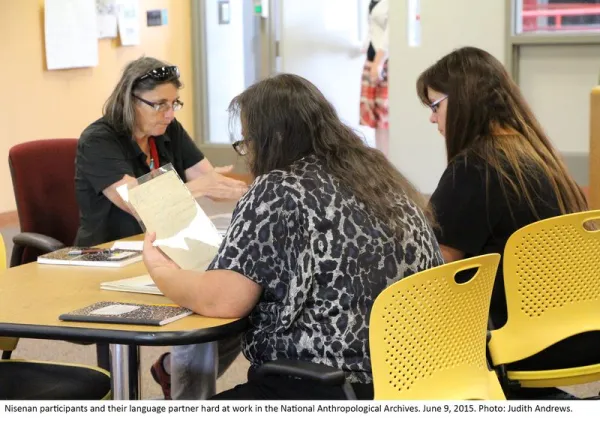
Search

News from Recovering Voices
The J.P. Harrington Collection: How one scholar’s early 20th Century dedication to collaborative native language documentation impacted Breath of Life participants of 2015
By: Laura Sharp with contributions from Breath of Life 2015 participants mentioned
06/17/2015

It is hard to judge whether John Peabody Harrington (1884-1961) knew the impact he would have on native languages and communities nearly a century after the peak of his research. As an ethnographer and linguist of the Smithsonian Institution’s Bureau of American Ethnology (BAE) (1915 to 1955), Harrington was exceptionally prolific. During his 40 years at the Smithsonian Institution, he amassed a collection of notes, vocabularies and publications so vast that it spanned 130 languages, over 1 million pages of notes, 200 sound recordings and 3500 photographs (NAA 2015). His collection is cared for by the Smithsonian Institution’s National Anthropological Archives at the National Museum of Natural History’s Museum Support Center in Suitland, Maryland.
This collection is of special importance the native communities who are losing languages or have lost their first language speakers. “For many of these languages it is the best historic record; for some, it is the only surviving record…Linguists and communities interested in language revitalization consider the collection a treasure.” (NAA, 2015). For many participants at this year’s Breath of Life Archival Institute for Indigenous Languages in Washington, D.C, the J.P. Harrington collection alone is reason enough to attend. This year, 14 different languages are represented at the 2-week workshop, all of which will benefit to some degree from the notes, photographs, and vocabularies of the J.P. Harrington collection.
For the Nisenan participants at Breath of Life, the J.P. Harrington collection has proven invaluable. Key pieces of information about the language have been found in the collection including certain placenames not known to be recorded anywhere else. In reviewing Harrington’s field notes, Dr. Sheri Tatsch who has worked with the collection now for 15 years, explains how Harrington quickly discovered that Nisenan is comprised of several dialects, something which no one had caught on to prior. Harrington’s ‘perfect ear’ allowed him to determine that the “Nisenan language is tonal, like the word for duck in Mandarin”, and that length of a word can completely change the meaning of a word. Dr. Tatsch’s work with the collection and Nisenan language community has shown her that Harrington left clues embedded throughout his field notes that provide critical insights into the language that simply do not exist elsewhere. And despite the fact that the collection, like countless other collections and archival records is certainly not without errors-such as the mislabeling of other’s work under the Harrington collection in some instances-it offers the Nisenan language learners perhaps one of their most valuable sources of Nisenan linguistic and cultural information.

For Regina Gradias and Sylvia Regalado of the Barbareño Band of Chumash Indians, the J.P. Harrington collection is quite personal. Descendants of three generations of Barbareño Chumash women who worked directly with Harrington, seeing the collection “put everything into perspective”. Both women grew up knowing about their lineage and have long carried a strong sense of responsibility, and calling to the language. To them, J.P. Harrington was a family friend of their great grandmothers’ who spent a considerable amount of time with their family, even traveling with their Great Grandmother, Lucrecia Garcia, to Washington, D.C. to help document the language. But it wasn’t until they saw the records of the personal letters from their own relative to J.P. Harrington in the archives, they felt a sense, as Ms. Regalado explained, “that language reclamation really was possible”.
During their two weeks in the National Anthropological Archives, they saw just a fraction of the full collection, however there were some notable finds. Harrington’s field notes in particular contained many special stories about Barbareño Chumash culture. Ms. Gradias explained how “a lot of culture was shared, and that’s important…it showed how things in our community revolved around culture. It captured who we are as a community”. An even more significant find was a photo of Ms. Gradias’ great grandmother, the last fluent Barbareño Chumash speaker, standing in front of the Smithsonian Castle. This was the same castle where the two women had spent their first day at the Breath of Life Archival Institute for Indigenous Languages in Washington, D.C. This photo which they had never seen before was discovered as a small icon when searching the online archival database. They were able to locate the original file and see it firsthand, again reminding them of their connection to the collection. The two later recreated the image by each standing in the same location in front of the Castle to commemorate how 50 years later, another generation of Barbareño Chumash women were continuing the work to save their language. For both, Breath of Life 2015 has been an inspiration. “Breath of Life put everything into perspective. Coming here has opened the door and set us on a path to make revitalization a reality, it brought it to life for us” - Regina Gradias.

The complete J.P. Harrington collection is available online thanks to those who helped make the Harrington collection more widely accessible to the interested public. Support for preparation and digitization of the collection for online access has been provided by the following: Arcadia Fund; Colorado College Library; Cow Creek Band of Umpqua; Pechanga Band of Luiseno; Recovering Voices, SI; Rosetta Project, Long Now Foundation; Save America’s Treasures, DoI; Matthew Vestuto, on behalf of Barbareño/Ventureño Band of Mission Indians; Advocates for Indigenous California Language Survival (AICLS); and the Collections Program of the National Museum of Natural History. Visit the collection: http://anthropology.si.edu/naa/harrington/index.html
The Breath of Life Archival Institute for Indigenous Languages is a biennial event and this year was co-organized by the Myaamia Center of Miami University and the Recovering Voices program at the National Museum of Natural History, with the National Museum of the American Indian and the Library of Congress.